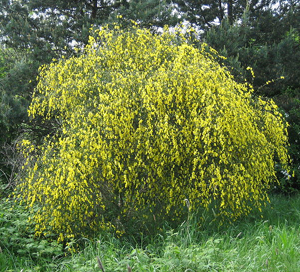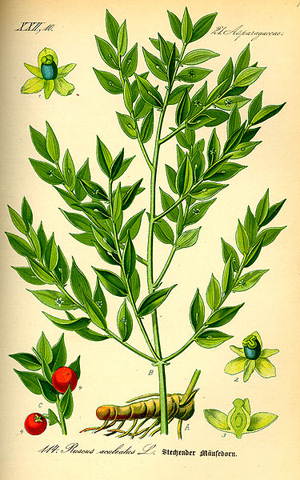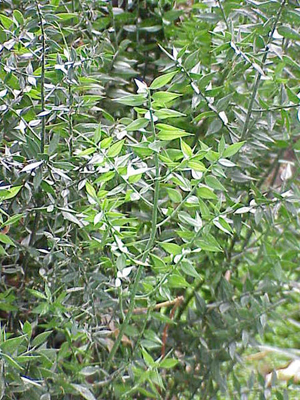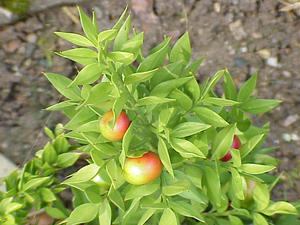Contents:
Common Names | Parts Usually Used | Plant(s) & Culture | Where Found | Medicinal Properties | Biochemical Information
Legends, Myths and Stories | Uses | Formulas or Dosages | Warning | Resource Links | Bibliography
Scientific Names

- Cytisus scoparius L.
- Ruscus Aculeatus
- Papiloniaceae
- Pea family
Common Names
- Broom flowers
- Broom tops
- Butcher’s broom
- Common broom
- Irish broom
- Link
- Scotch broom
Parts Usually Used
Young flowering twigs, tops, and seeds
Back to Top

Description of Plant(s) and Culture
An attractive, evergreen shrub, it has bright green, almost leafless stems; erect green branches from which oval leaflets grow, with bright yellow pea-like flowers, much favored by butterflies, blooms in April to June. The height ranges from
Another herb, called Butcher’s Broom (Ruscus acluteatus) is extremely popular among European women. They use it to treat discomfort and pain of restless leg syndrome, caused by poor circulation; that heavy leg feeling.
Back to Top

Where Found
A native of Europe, Asia, and Africa, broom has become naturalized in some parts of North America. Found on dry, gravely banks, heaths and hillsides, particularly in the rural areas of the western United States.
Back to Top
Medicinal Properties
Tops: cathartic, diuretic
Seed: cathartic, emetic
Back to Top
Biochemical Information
Alkaloids, hydroxylramine, 42% potash, and ruscogenins, tannin, bitter principle, and traces of an essential oil.
Back to Top

Legends, Myths and Stories
Broom is one of the nine fairy herbs, and a cologne prepared from its flowers is said to inspire affection.
The branches of this shrub produced crude but useful brooms, hence the name.
Scotch broom is used in beer makings and flavorings.
Back to Top

Uses
For circulatory disorders, gout, leg cramps, varicose veins, hemorrhoids, phlebitis, thrombosis, and jaundice . Good for kidney and bladder. Relieves inflammation. Excellent for dropsy, toothache, ague, acute constipation, swelling of the spleen.
Used with uva-ursi, cleavers, and dandelion makes an excellent remedy for cleansing the kidneys and bladder, and to increase the flow of urine. Makes a good ointment for lice or vermin. A cardiac depressant to quiet an overactive heart. A lymph tonic.
One of the legumes, it also increases available nitrogen in the soil, benefiting plants growing around it, and is a collector of calcium.
Back to Top
Formulas or Dosages
The tops of young branches should be picked, and an infusion made using
Decoction: prepared from the root, boil
Back to Top
Warning
Large doses can cause vomiting, purging, weakening heart, lowered nerve strength and low blood pressure. Advanced stages of toxicity can cause complete respiratory collapse. It also speeds up the heartbeat. Large doses have been reported to cause fatal poisoning.
Broom contains alkaloids and hydroxytyramine, and should not be used except under proper medical supervision.
Back to Top
Resource Links
LiveStrong.com: Butcher’s Broom & Hemorrhoids
Memorial Sloan-Kettering Cancer Center: Butchers Broom
U.S. National Library of Medicine: Scotch Broom
Bibliography
![]() Back to Eden
Back to Eden, by Jethro Kloss; Back to Eden Publishing Co., Loma Linda, CA 92354, Original copyright 1939, revised edition 1994
![]() The Complete Medicinal Herbal
The Complete Medicinal Herbal, by Penelope Ody, Dorling Kindersley, Inc, 232 Madison Avenue, New York, NY 10016, First American Edition, copyright 1993
![]() Culpeper’s Complete Herbal & English Physician: Updated With 117 Modern Herbs
Culpeper’s Complete Herbal & English Physician: Updated With 117 Modern Herbs, by Nicholas Culpeper, Meyerbooks, publisher, PO Box 427, Glenwood, Illinois 60425, 1990, (reprint of 1814)
 Earl Mindell’s Herb Bible
Earl Mindell’s Herb Bible, by Earl Mindell, R.Ph., Ph.D., Simon & Schuster/Fireside, Rockefeller Center 1230 Avenue of the Americas, New York, New York 10020
![]() Indian Herbalogy of North America
Indian Herbalogy of North America, by Alma R. Hutchens, Shambala Publications, Inc., Horticultural Hall, 300 Massachusetts Avenue, Boston, Massachusetts 02115, 1973
Herbal Gardening, compiled by The Robison York State Herb Garden, Cornell Plantations, Matthaei Botanical Gardens of the University of Michigan, University of California Botanical Garden, Berkeley., Pantheon Books, Knopf Publishing Group, New York, 1994, first edition
 The Magic of Herbs
The Magic of Herbs, by David Conway, published by Jonathan Cape, Thirty Bedford Square, London, England. (Out of print)
![]() The Herb Book
The Herb Book, by John Lust, Bantam Books, 666 Fifth Avenue, New York, NY. copyright 1974.
![]() Planetary Herbology
Planetary Herbology, by Michael Tierra, C.A., N.D., O.M.D., Lotus Press, PO Box 325, Twin Lakes. WI 53181., Copyright 1988, published 1992
![]() American Folk Medicine
American Folk Medicine, by Clarence Meyer, Meyerbooks, publisher, PO Box 427, Glenwood, Illinois 60425, 1973
![]() Prescription for Nutritional Healing, Fifth Edition: A Practical A-to-Z Reference to Drug-Free Remedies Using Vitamins, Minerals, Herbs & Food Supplements
Prescription for Nutritional Healing, Fifth Edition: A Practical A-to-Z Reference to Drug-Free Remedies Using Vitamins, Minerals, Herbs & Food Supplements, by James F. Balch, M.D. and Phyllis A. Balch, C.N.C., Avery Publishing Group, Inc., Garden City Park, NY
![]() Webster’s New World Dictionary
Webster’s New World Dictionary, Third College Edition, Victoria Neufeldt, Editor in Chief, New World Dictionaries: A Division of Simon & Schuster, Inc., 15 Columbus Circle, New York, NY 10023
 The Rodale Herb Book: How to Use, Grow, and Buy Nature’s Miracle Plants (An Organic gardening and farming book)
The Rodale Herb Book: How to Use, Grow, and Buy Nature’s Miracle Plants (An Organic gardening and farming book), edited by William H. Hylton, Rodale Press, Inc. Emmaus, PA, 18049., 1974
